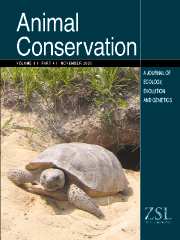Article contents
Conservation breeding for reintroductions: assessing survival in a captive flock of houbara bustards
Published online by Cambridge University Press: 29 August 2001
Abstract
Conservation breeding for reintroduction is becoming a popular option for restoring threatened populations. Whereas post-release results are widely reported in the conservation literature, little empirical information is presented on the captive populations that often make such releases possible, even though fecundity, fertility and survival rates can have an impact on the outcome and cost of wild population re-establishment. We present results of survival analyses carried out on a captive population of houbara bustards to determine peak periods of mortality, and by identifying sources of variations in mortality to recognize the potential impact of management practices on productivity. There were two main mortality peaks: during incubation (53% survival of fertile eggs), and by 6 months post-hatching (75% survival of hatchlings). Management-related variables influencing survival of eggs and chicks included the year when laid, the cohort of females laying them, and possibly sex. Most post-hatching deaths were due to trauma and infectious diseases. Trauma-related deaths usually follow collisions with cages, and imply selection for the captive environment, an undesirable trend in populations maintained for reintroductions. Reducing losses during incubation would have the largest impact on production of birds for reintroduction, enabling the release of more birds, and reducing the overall costs of the project.
- Type
- Research Article
- Information
- Copyright
- © 2001 The Zoological Society of London
- 6
- Cited by


